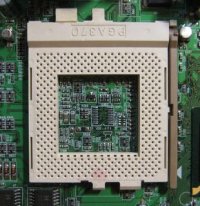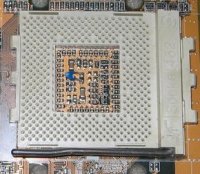CPU Sockets Roundup
By Stephen Bucaro
A CPU socket is used to connect a computer's CPU (Central Processing Unit)
to its motherboard. Modern CPUs use the PGA (Pin Grid Array) package.
With a PGA, the underside of the processor is covered with an array of metal
pins. To install a CPU, the pins are inserted into a ZIF (Zero Insertion Force)
socket mounted on the motherboard.
A ZIF socket has a lever to open the metal pin contacts in the socket so that
the processor can be dropped into place without using force. After the
processor is dropped into position, the lever is used to close the socket,
creating good electrical contact between the PGA pins and the socket.
The Slot Package
For a short time, processor manufacturer's found that a socket could not
handle the heat generated by the processor, nor did it provide enough real
estate for the L2 cache size desired. They began using a slot, similar
to an expansion card slot, rather than a socket, to mount their CPUs.

Intel used "Slot 1" to mount their Celeron and Pentium II processors, and
"Slot 2" to mount their Pentium II and Pentium III processors. AMD used "Slot A"
to mount their Athlon processors. These "Slot" processors tended to jiggle
loose, especially during shipping. Processor manufacturer's soon returned to
using a socket to mount the CPU.
The Socket Package

Intel replaced the "Slot" CPU interface with "Socket 370" for their Celeron
and Pentium III processors. The "370" refers to the number of holes in the
socket for CPU pins.

AMD replaced "Slot A" with "Socket A" for their Duron, Sempron, and Athlon
Thunderbird and XP/MP processors. "Socket A" is also known as "Socket 462"
because, although there are 453 pins in the socket, nine pins are blocked to
prevent insertion of Socket 370 CPUs.
| 
